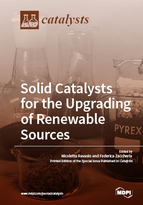Solid Catalysts for the Upgrading of Renewable Sources
A special issue of Catalysts (ISSN 2073-4344). This special issue belongs to the section "Biomass Catalysis".
Deadline for manuscript submissions: closed (31 July 2018) | Viewed by 59457
Special Issue Editors
Interests: heterogeneous non-toxic and non-noble catalysts; solid catalysts; agri-food waste valorization
Special Issues, Collections and Topics in MDPI journals
Special Issue Information
Dear Colleagues,
The use of solid catalysts for the upgrading of renewable sources gives the opportunity to combine the two main cores of green chemistry, that is, on the one hand, the setting up of sustainable processes and, on the other, the use of biomass-derived materials. Solid catalysts have taken on a leading role in traditional petrochemical processes and could, therefore, also represent a key tool in new biorefinery driven technologies.
This Special Issue will cover topics related to the preparation and use of heterogeneous catalytic systems for the transformation of renewable sources, as well as of materials deriving from agro-industrial wastes and by-products. Valorization of rest raw materials represents a crucial challenge in the roadmap to a circular economy.
At the same time, the ever-increasing importance of bioproducts, due to the acceptance and request of consumers, makes the upgrading of biomass into chemicals and materials, not only an environmental issue, but also an economical advantage.
In this Special Issue we invite the main groups involved in heterogeneous catalysis applied to renewable materials to contribute original papers, mini reviews or commentaries in order to give an overview of the state-of-the-art in this field and an interpretation of the open challenges and opportunities. The main focus will be devoted to the transformation and upgrading of:
- Lignocellulosic materials
- Vegetable oils
- Terpenes
- Agro-industrial wastes and by-products
Prof. Dr. Nicoletta Ravasio
Dr. Federica Zaccheria
Guest Editors
Manuscript Submission Information
Manuscripts should be submitted online at www.mdpi.com by registering and logging in to this website. Once you are registered, click here to go to the submission form. Manuscripts can be submitted until the deadline. All submissions that pass pre-check are peer-reviewed. Accepted papers will be published continuously in the journal (as soon as accepted) and will be listed together on the special issue website. Research articles, review articles as well as short communications are invited. For planned papers, a title and short abstract (about 100 words) can be sent to the Editorial Office for announcement on this website.
Submitted manuscripts should not have been published previously, nor be under consideration for publication elsewhere (except conference proceedings papers). All manuscripts are thoroughly refereed through a single-blind peer-review process. A guide for authors and other relevant information for submission of manuscripts is available on the Instructions for Authors page. Catalysts is an international peer-reviewed open access monthly journal published by MDPI.
Please visit the Instructions for Authors page before submitting a manuscript. The Article Processing Charge (APC) for publication in this open access journal is 2700 CHF (Swiss Francs). Submitted papers should be well formatted and use good English. Authors may use MDPI's English editing service prior to publication or during author revisions.
Keywords
- Heterogeneous catalysis
- Bioproducts
- Biomass
- Lignocellulosic raw materials
- Vegetable oils
- Terpenes
- Solid Lewis acids
- Selective hydrogenation
- Bifunctional catalysis







